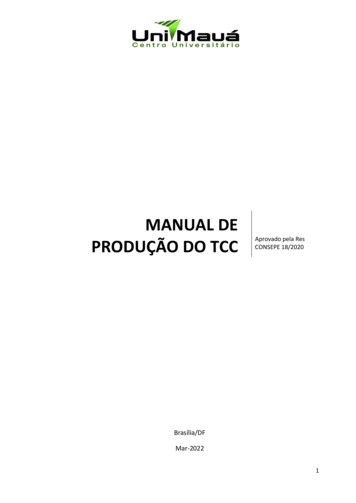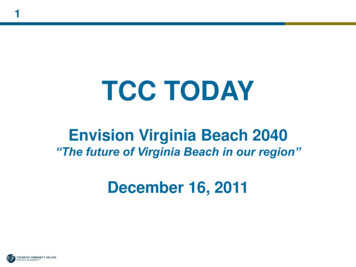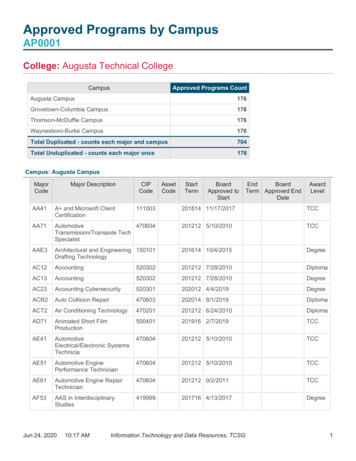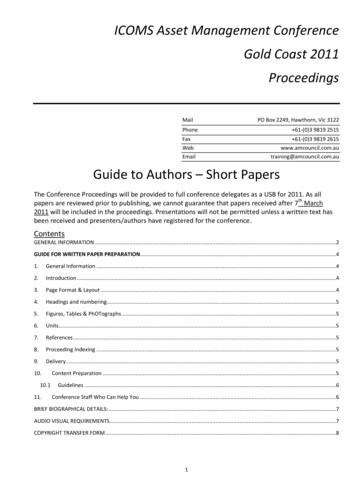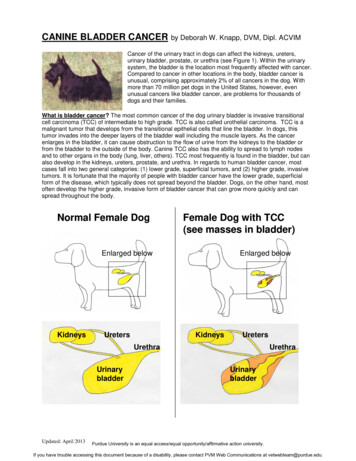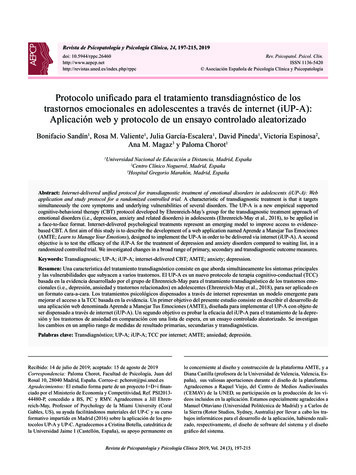
Transcription
TCC 2013 Conference ProceedingsE-Learning in the 21st Century: Multimedia, Differentiation and DiversityDr. Ruby EvansAdjunct Assistant ProfessorColorado Technical UniversityColorado, USAruby.evans2@faculty.ctuonline.eduAbstract: Continuous quality improvement in the curriculum is a viable concern,especially for online and for-profit colleges that offer distance education. Thisresearch commenced with a conceptual framework that highlighted the relevanceof integrating multimedia, differentiated learning activities, and culturallysensitive materials and activities in an online setting. The author reviewed thepublished literature to identify findings that support continuous qualityimprovement of online curricula through integration of these constructs.Teaching and Learning in a Technological AgeWhich model is best for student learning—on ground, hybrid, online? As Brunner (206,p. 230) wrote: “ all things being equal, hybrid courses potentially offer a moreeffective learning environment than either traditional face-to-face or online coursesseparately.” Rather than one venue being better than the other, individual learners maybe better suited to one environment than the other. That being said, however, many adultlearners prefer fully online instruction—whether by virtue of choice, necessity, orconvenience—amid competing responsibilities of family, work and personalresponsibilities.The National Center for Education Statistics (NCES, 2011) summarized 2007-08postsecondary enrollment data across four institutional types (public 2-year colleges, forprofit, public 4-year, and private nonprofit 4-year institutions). NCES reported more than35 percent of all undergraduates enrolled in a distance education program were enrolledat a for-profit college. Many of these institutions remain concerned about the issue ofquality for online educational programs, especially as compared to face-to-face delivery(Chao, Saj, & Tessier, 2006).Online education, combined with effective pedagogy and reflective teaching, hastransformed higher education. It offers an increasingly popular and alternative route totraditional classroom teaching (Evans, 2007). The proliferation of distance and onlinelearning program in higher education is a direct consequence of an information-based,technologically integrated society. Online instruction can certainly be rigorous as onground instruction, provided that the facilitator and students engage in active learningenvironments replete with quality curricula, vibrant discussion, and opportunities toscaffold learning.
TCC 2013 Conference ProceedingsHow we view teaching usually translates across medium, whether on ground, hybrid, oronline. For example, Evans (2004) suggested:Students are entitled to quality instruction in an active and stimulating learningenvironment. They should experience frequent and repeated opportunities toact, react, and interact with each other and the professor. Curriculum materialsshould be timely and relevant. Standards of excellence high, yet attainableshould be used to facilitate optimal student learning. Finally, as teaching is aprocess, not an activity, my teaching philosophy advocates an invaluablereflective view on how to strive for instructional improvement.And yet, information technology is promoting fundamental changes in how we teach andin how we learn. Per Garrison and Anderson (2003, p. 106), “E-learning is not anexperiment. It has moved into the mainstream of higher education and is beginning to berecognized as a strategic asset.”Conceptual FrameworkMultimedia applications, such as video clips, flash presentations, and animations canenhance online courses, which are otherwise text-based. Schilling (2009) usedqualitative content analyses and statistical comparison of quantitative data to demonstratesignificant improvements in the level of students' engagement in course materials andwith peers. Differentiation in learning activities through providing alternate forms ofassessing learner mastery of content can also be helpful in online courses. While onlinework often involves writing, students should also be allowed to produce presentations(e.g., PowerPoint) and construct analyses, in addition to writing essays or narrative. In asimilar vein, Haring, Titus, Stevens and Estrada highlight the importance of usingassessments that have evidence-based validity in assessing the learning gains of variousnon-majority populations. Accordingly, the conceptual framework for this researchposits that quality online curricula and related courses are comprised of dynamic andinteractive learning elements that incorporate use of multimedia, differentiated learningactivities, and culturally sensitive learning activities (See Figure 1).Figure 1: Conceptual Framework for Quality Online Curricula
TCC 2013 Conference ProceedingsThree Areas of Interaction in Online LearningThree areas of interaction are typically identified as meaningful in online and distanceeducation courses: learner-content interaction; learner-instructor interaction and; learnerlearner interaction (Kirby, 1999; Moore & Kearsley, 1996). First, regarding learnercontent interaction, Hinson and LaPrairie (2005) reported findings from a meta-analysisof empirical studies revealing that the effects of distance education on studentachievement were correlated significantly with how courses were designed and withwhether or not creators employed interactive media and sound online pedagogical andinstructional design strategies.Secondly, Evans (2007) suggested a variety of equivalence strategies empowering onground instructional faculty to support learner-instructor interaction and to achievesuccess in online learning environments. One key adjustment is that the effectiveinstructor must become a co-learner with the students and a facilitator of knowledge. Theubiquitous Web expands the knowledge base of the learners and rails in the face of theinstructor serving as a primary and sole arbiter of knowledge. In virtual settings, theonline teacher’s role is more of a facilitator than a lecturer (Stansfield, McLellan, &Connolly, 2004). In essence, then, a primary role of the online instructor is to offer asupportive presence in which virtual learners feel fully engaged and connected, therebymitigating their anger and stress (Diekelmann & Mendias, 2005).The online format also poses challenging demands on the instructor or facilitator, and theskills faculty need are not far removed from those that successful online students use. Acadre of core characteristics, qualities, and/or skills is also needed in the onlineclassroom. Based on more than 22 years of integrating technology into Web-enhanced,hybrid, and/or fully online instruction, the author has compiled this non-exhaustivedescription of an effective online facilitator:ooooooooooooActive learner (Tambouris, 2012);Conveyer of knowledge in specific content/discipline;Counselor and mentor;Critical thinker;Learning-centered educator (Estes, 2004);Organizer;Promoter and sustainer of multiple interactions—learner-learner; learnerinstructor; learner-content;Proponent of information and technological literacy (Leonard, 2001);Reflective learner;Respecter of diversity;Skilled mediator and conflict resolver; and,Student-centered educator.The facilitator has a key role in helping to build and to sustain the learning communityand the sense of community so that all members feel and are authentically included. This
TCC 2013 Conference Proceedingsrole, notwithstanding, learners have a requisite responsibility, as well, to practiceinclusive discussion. Yet, the instructor must effectively model that discussion, as thelearners tend to look to that individual for their primary cues. It can certainly be morechallenging to establish these conditions and parameters in online settings in the absenceof verbal expression and other cues derived from face-to-face communication.Lastly, the literature is replete with studies (Beaudoin, Kurtz, & Eden, 2009; Seckel,2007) in which researchers identify characteristics typically associated with successful elearners. They are well-organized, disciplined and focused, self-directed, self-motivated,independent, and autonomous; able to think critically; able to manage time; have accessto and the ability to master technological tools; and possess academic and socialmaturity. To support learner-learner interaction, online learning experiences shouldoffer full equity and inclusion for all learners, including those of diverse culturalbackgrounds (Smith & Ayers, 2006).MethodsThis study involved a review of the literature through examination of five questionscommon to discussions regarding quality matters in distance and/or online education:1. What is an operational definition for quality online curricula?2. What does a review of the literature reveal regarding the use of enhancedmultimedia in online learning environments?3. What does a review of the literature reveal regarding the use of differentiatedand/or multiple learning activities in online learning environments?4. What does a review of the literature reveal regarding the use of culturallysensitive activities in online learning environments?5. What criteria appear to represent best practices in online curricula for enablingadult learners to learn best in a dynamic, engaging, and intellectuallystimulating online learning community?ResultsQuality online curricula include dynamic and interactive teaching and learning materialsthat provide frequent and repeated opportunities for instructor-learner interaction, learnercontent interaction, and meaningful learner-learner interaction (Kirby, 1999; Moore &Kearsley, 1996).Enhanced multimediaEnhanced multimedia integration within online courses supports student-centeredinstruction (Hinson & LaPrairie 2005). Multimedia integration may includeincorporation of online video and audio files, PowerPoint presentations,podcasts/vodcasts, discussion boards and classroom E-newsletter. Schilling (2009)stressed the importance of educators continuing to take advantage of the wide variety ofmultimedia learning tools and online course to improve the quality of the educationalexperience.
TCC 2013 Conference Proceedings“When integrating online components such as video files and multimedia, such asPowerPoint, to supplement instruction and lecture notes, instruction becomes morestudent centered.” (Hinson and LaPrairie, p. 488). Internet technologies should be usedto facilitate interpersonal exchanges that support learner-learner and learner-instructorinteraction. Interaction should be facilitated and encouraged among learners, content,instructors, and external content experts, both individually and within groups.Virtual learners should be encouraged to develop information literacy skills throughusing the Web to collect and analyze data. Recommended strategies include webquests,webliographies, annotated bibliography, and resource sharing. Using the constructivistapproach, learners should actively identify new links to relevant, culturally appropriatewebsites. In this way, learners may enhance the learning experience by sharing culturallyrich information with their instructor and peers (Smith & Ayers, 2006).Differentiated instructionTo foster a sense of ownership among participants in a learning experience, educatorsmust include a variety of tasks and projects designed to demonstrate achievement oflearning objectives as well as authentic assessment of learning outcomes based onlearner-selected criteria (Smith & Ayers, 2006). Multiple perspectives may alsopermeate the learning experience when leaders and experts in the learners’ immediatecommunities are invited to participate in course planning, design, implementation, andevaluation (Smith & Ayers, 2006).Differentiated learning activities have the potential to support deep and authenticlearning, whereby students attempt to understand what is presented and relate suchinstruction to the real world. Accordingly, increased use of Web searches, scholarlypapers for critique and discussion, peer study groups, case studies, and real worldexamples helps to support student learning.“Sanchez and Gunawardena (1998) recommend the following: In general, when trying toaccommodate a variety of learning styles in the instructional design, it is always best todesign alternative activities to reach the same objective and give the students the optionof selecting from these alternative activities those which best meet their preferredlearning style. (p. 59)” (as cited in Smith & Ayers, 2006). In online settings,differentiated instruction is nonnegotiable.Culturally sensitive learning activitiesA substantive case has been made for inclusion of culturally sensitive learning activitieswithin the online environment. In particular, studies have been conducted that emphasizehow those students considered members of non-western cultural groups prefercollaborative learning activities. Smith and Ayers (2006) reported that students fromnon-western backgrounds prefer academic work that emphasizes group collaboration—group projects, the continued integration of discussion boards, and peer study groups.
TCC 2013 Conference ProceedingsAlso, many non-Western learners may have a strong preference for feedback (Sanchez &Gunawardena, as cited in Smith & Ayers, 2006).Clark (2000) identified the following as ways to stimulate collaborative learning inonline teaching and learning environments:o Public introduction and basic bio by the instructor/studentso The ongoing discussiono The debate with students divided into groups and assigned opposite sidesof an argument to defend.o Group projects with small, manageable groups to collaborate on a project.o A group paper where each student can be assigned to write a portion of thepaper.o Provide personal and group online workspaces that encourage both privatereflection and cooperative support (Smith & Ayers, 2006).Sanchez and Gunawardena (as cited in Smith & Ayers, 2006) provide guidelines fordesigning distance instruction and support for culturally diverse learners. They note thatHispanic/Latino adult learners often demonstrate a strong preference for feedback, oftenprefer activities that are collaborative rather than competitive (e.g., group projects), andalso show a preference for reflectivity that is well-supported by asynchronous discussionboards. These technologies allow culturally diverse learners virtual ‘wait time’ to thinkabout questions and then formulate appropriate answers.Best practices in online curricula and instructionLewis (2006) reported the use of learning objects such as video clips and other digitalresources as a common strategy among exemplary online faculty. Best practices inonline instruction also include incorporation of differentiated learning activities: casestudies; collaborative learning; discussion forums; projects; self-directed learning, andsmall group work (Illinois Online Network, 2007). In online environments, communitiesof inquiry facilitate the development of social support networks and learner-to-learneramong learners that can be helpful for culturally diverse and adult learners (Smith &Ayers, 2006).ConclusionContinuous quality improvement in the curriculum is a viable concern. This researchreviewed the published literature to identify findings that support continuous qualityimprovement of online curricula. The research commenced with a conceptual frameworkthat highlighted the relevance of integrating multimedia, differentiated learning activities,and culturally sensitive materials and activities in an online setting.Use of enhanced multimedia has the potential to more actively engage e-learners.Differentiated learning activities help to enhance deep learning whereby students attempt
TCC 2013 Conference Proceedingsto understand what is presented and relate such instruction to the real world. Studieshave been conducted that emphasize how those students considered members of nonwestern cultural groups prefer collaborative learning activities. Instruction, whichencourages peer and group collaboration— group projects, the continued integration ofdiscussion boards, and peer study groups—supports culturally sensitive learning activitiesfor diverse learners.ReferencesBeaudoin, M. F., Kurtz, G., & Eden, S. (2009). Experiences and opinions of e-learners:what works, what are the challenges, and what competencies ensure successfulonline learning. Interdisciplinary Journal Of E-Learning & Learning Objects,5275-289.Brunner, D. L. (2006). The potential of the hybrid course vis-à-vis online and traditionalcourses. Teaching Theology and Religion, 9(4), 229–235.Chao, T., Saj, T., & Tessier, F. (2006). Establishing a quality review for online courses.Educause Quarterly (November 3, 2006), 32-39.Clark, J. (2000). Collaboration tools in online learning environments. ALN Journal,4(2).Diekelmann, N., & Mendias, E. P. (2005). Being a supportive presence in online courses:Attending to students' online presence with each other. Teacher Talk, 44(9), 39395.Estes, C. A. (2004). Promoting student-centered learning in experiential education.Journal Of Experiential Education, 27(2), 141-160.Evans, R. (2004). Statement of Educational and Teaching Philosophy, University ofCentral Florida, Faculty Center for Teaching & Learning, Retrieved December27, 2012, lassrooms/philosophies/evans.phpEvans, R. (2007). Adapting on ground teaching strategies to the WWW: The odysseycontinues. Technology, Colleges, and Community Worldwide Online ConferenceApril 1 7-19, 2007.Retrieved December 27, 2012, pdfGarrison, G. R. & Anderson, T. (2003). E-learning in the 21st century. New York:Routledge Falmer: Taylor & Francis Group.Friere, P. (1972). Pedagogy of the oppressed. New York: Herder.
TCC 2013 Conference ProceedingsHaring, R. C., Titus, J. C., Stevens, L. H., & Estrada, B. D. (2012). Increasing theknowledge base: Utilizing the GAIN in culturally sensitive landscapes. FourthWorld Journal, 11(2), 79-94.Hinson, J. M. & LaPrairie, K. N. (2005). Learning to teach online: Promoting successthrough professional development. Community College Journal Of Research andPractice, 29, 483–493.Illinois Online Network (2010). Instructional Strategies for Online Courses. Chicago,IL: University of Illinois. Retrieved on December 27, 2012, ls/pedagogy/instructionalstrategies.aspKirby, E. (1999). Building interaction in online and distance education courses.Leonard, J., & Guha, S. (2001). Education at the crossroads: Online Teaching andStudents' perspectives on distance learning. Journal Of Research On TechnologyIn Education, 34(1), 51-57.Lewis, C. C., & Abdul-Hamid, H. (2006). Implementing Effective Online TeachingPractices: Voices of Exemplary Faculty. Innovative Higher Education, 31(2), 8398. doi:10.1007/s10755-006-9010-zMoore, M. G. (1989). Three types of interaction. American Journal of DistanceEducation, 3(2), 1-6.Moore, M. G., & Kearsley, G. (1996). Distance education: A systems view. Belmont,CA: Wadsworth.National Center for Education Statistics (NCES). (2011). Learning at a distance:Undergraduate enrollment in distance education courses and degree programs.Publication No. NCES 2012154, Retrieved December 27, 2012, d 2012154Seckel, S. (2007). Characteristics and responsibilities of successful e-learners. Journal ofInstruction Delivery Systems, 21(2), 22-26.Schilling, K. (2009). The impact of multimedia course enhancements on student learningoutcomes. Journal of Education for Library & Information Science, 50(4), 214225.Smith, D. R. & Ayers, D. F. (2006). Culturally responsive pedagogy and onlineLearning: Implications for the globalized community college. CommunityCollege Journal of Research and Practice, 30, 401–415.Stansfield, M. McLellan, E., & Connolly, T. (2004). Enhancing student
TCC 2013 Conference Proceedingsperformance in online learning and traditional face-to-face class delivery.Journal of Technology Education, 3, 173-188.Tambouris, E., Panopoulou, E., Tarabanis, K., Ryberg, T., Buus, L., Peristeras, V., & .Porwol, L. (2012). Enabling problem based learning through web 2.0technologies: PBL 2.0. Journal Of Educational Technology & Society, 15(4), 238251.
Internet technologies should be used to facilitate interpersonal exchanges that support learner-learner and learner-instructor interaction. Interaction should be facilitated and encouraged among learners, content, instructors, and external content experts, both individually and within groups. . TCC 2013 Conference Proceedings , , ,
